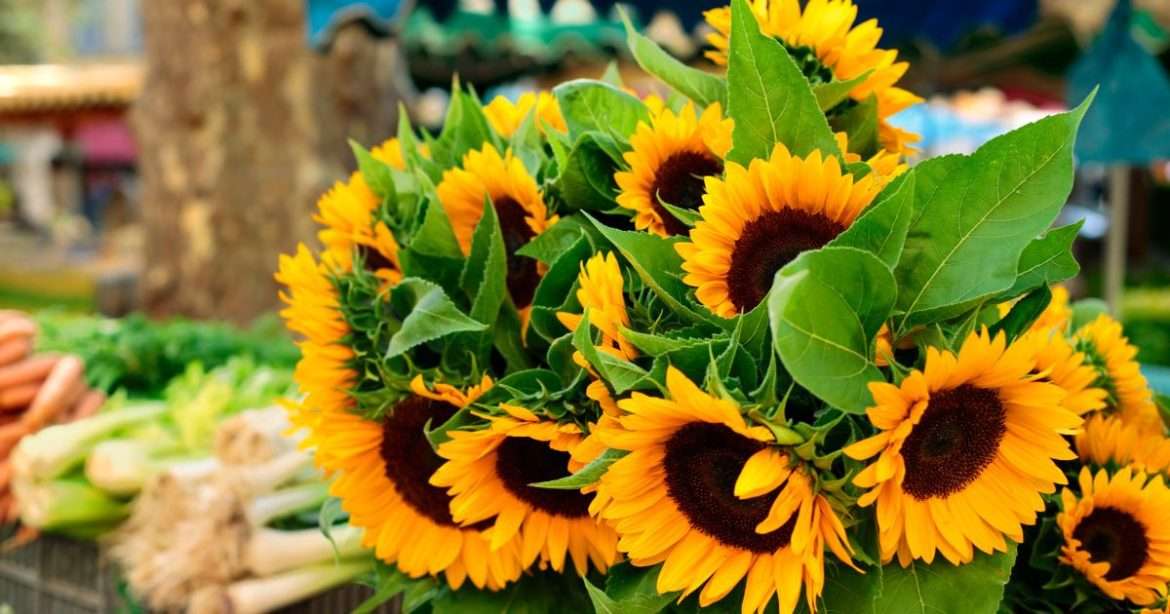Table of Contents
Welcome to The Ultimate Guide: Expert Tips on Easily Drying Sunflowers! If you’ve ever been captivated by the vibrant beauty of sunflowers and wished to preserve them for longer periods, this article is perfectly tailored for you. With our comprehensive guide, we will share a range of expert tips and techniques that will make drying sunflowers an effortless task. Whether you’re a seasoned gardener or a novice flower enthusiast, this ultimate guide has got you covered with all the information and strategies needed to successfully dry these iconic blooms. So get ready to embark on a journey where nature’s golden gems can remain stunning long after their initial bloom.
Choosing The Right Sunflowers For Drying
When it comes to drying sunflowers, selecting the right varieties is crucial. Here are some tips to help you make the best choice:
- Opt for single-stemmed varieties: Single-stemmed sunflowers are easier to dry than those with multiple stems. Their uniformity in size and shape makes them more suitable for hanging or arranging.
- Look for sturdy stalks: Sunflowerstalks that are strong and thick will be able to support the weight of their blossoms without wilting or breaking during the drying process.
- Consider color preference: Depending on your aesthetic preferences, you can choose from a wide range of sunflower colors – from classic yellow to vibrant red or even bi-colored blooms. Make sure to select flowers that will retain their color when dried.
Remember, choosing the right sunflowers is essential not only for successful drying but also for creating stunning arrangements that stay beautiful long after they’ve been cut!
Best Time To Harvest Sunflowers For Drying
- Harvest the sunflowers when the back of their heads turn yellow-brown. This indicates that the petals and seeds have dried out and are ready for harvesting.
- Check for drooping leaves or bent stems as a sign of maturity. Sunflowers should be fully mature before they are harvested to ensure proper drying and preservation.
- Avoid harvesting too early or too late in the day. Early morning or late afternoon is generally a good time to harvest sunflowers as they will not be affected by high temperatures.
It is important to harvest sunflowers at the right time for optimal drying results. By following these tips, you can ensure that your sunflower heads are properly dried and preserved for decorative purposes or later use in crafts and arrangements. Remember, timing is key when it comes to getting beautiful, long-lasting dried flowers!

Preparing Sunflowers For Drying: Step-by-Step Guide
Here are steps of preparing sunflowers for drying.
1. Harvesting Stage:
- Wait until the sunflower flowers have reached full bloom, with petals fully opened.
- Use a sharp knife or pruner to cut the sunflower heads from the stem, leaving about 12 inches of stem attached.
2. Removing Leaves:
- Gently remove any leaves on the stem near the base of the flower head.
- Leave a small portion of leaves attached at the base to help preserve moisture during drying.
3. Bunching and Hanging:
- Group several sunflower stems together and loosely tie them with twine or rubber bands.
- Hang these bunches upside down in a dry, well-ventilated area away from direct sunlight.
Remember that proper preparation is key for successfully drying sunflowers. By following these simple steps, you can ensure that your sunflowers maintain their vibrant colors and beautiful shape throughout the drying process.
Hanging vs Air Drying Sunflowers: Pros And Cons
Below are stated pros and cons of drying sunflowers by hanging or air drying.
Hanging Drying Method:
-
Pros:
- Easy to set up and requires minimal materials.
- Allows the flowers to dry slowly, preserving their shape and color.
- Can be used to create beautiful dried flower arrangements.
-
Cons:
- Takes longer for the sunflowers to dry compared to air drying.
- Requires a suitable hanging location with good airflow.
Air Drying Method:
-
Pros:
- Faster method of drying sunflowers compared to hanging.
- Does not require any special equipment or space.
- Ideal for those who want quick results.
-
Cons:
- Flowers may lose some of their shape and color due to quicker drying process.
- Not suitable for creating elaborate dried flower arrangements.
The Importance Of Proper Ventilation In Drying Sunflowers
Proper ventilation is vital when drying sunflowers to ensure optimum drying conditions and prevent mold growth or moisture damage.
- Preventing Mold Growth: Sunflowers require adequate airflow during the drying process to prevent the formation of mold. Mold can thrive in dark, damp environments, which can be created if there is insufficient air circulation. By providing proper ventilation, you can help eliminate excess moisture and discourage mold growth.
- Avoiding Moisture Damage: Without proper airflow, sunflower seeds may not dry evenly or thoroughly, resulting in moisture damage that affects their quality. Adequate ventilation ensures that all parts of the sunflower are exposed to air which helps facilitate consistent and efficient drying.
- Maintaining Aroma and Color: Sunflowers that are properly dried with adequate ventilation retain their natural aroma and vibrant color for longer periods compared to those dried without proper airflow.
To achieve optimal results when drying sunflowers, it is essential to prioritize proper ventilation throughout the process.
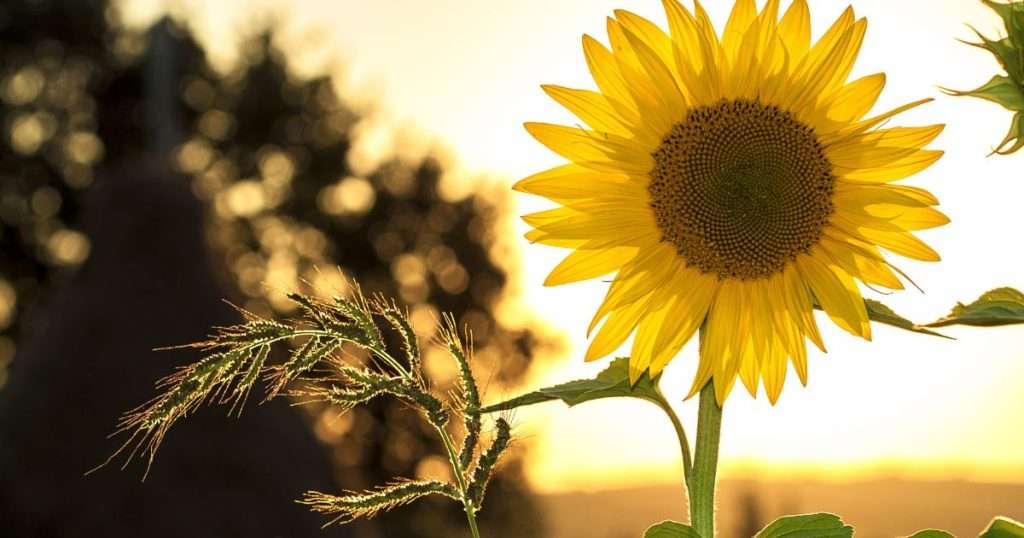
How To Create A Drying Rack For Sunflowers
To create a drying rack for sunflowers, you will need the following materials:
- Wooden dowels or sturdy sticks
- String or twine
- Scissors
Now follow the given steps.
- Start by cutting four pieces of wooden dowels or sturdy sticks, each measuring about 2 feet in length.
- Arrange the dowels in a square shape, with the ends overlapping slightly to form corners. Secure the corners together using string or twine, tying them tightly so that they hold their shape.
- Cut two additional pieces of string or twine, each measuring about 3 feet in length.
- Tie one end of each piece of string to opposite corners of the drying rack square, creating a crisscross pattern across the top.
- Ensure that the strings are taut and tied securely at each corner.
- Your DIY sunflower drying rack is now ready to be used! Simply hang your freshly cut sunflowers upside down from the cross sections of string or twine and allow them to dry naturally.
Ideal Conditions For Drying Sunflowers
To achieve optimal results when drying sunflowers, it is crucial to consider temperature and humidity levels. These factors play a significant role in preserving the vibrant colors and overall quality of the flowers.
Temperature:
- Aim for a cool, dry environment with temperatures between 65°F (18°C) and 75°F (24°C).
- Extreme heat can cause the petals to wilt or discolor, while cold temperatures may slow down the drying process.
- Maintain consistent temperature throughout the drying period to ensure even preservation.
Humidity:
- Low humidity levels are ideal for drying sunflowers effectively.
- Aim for relative humidity below 50% to prevent mold growth.
- High moisture content can lead to mold development and compromise flower quality.
By controlling both temperature and humidity during the drying process, you can successfully preserve your sunflowers without compromising their color or shape. Remember that monitoring these conditions regularly will greatly contribute to achieving desirable results.
How Long Does It Take To Dry Sunflowers?
Drying sunflowers typically takes around two weeks. During this time, the flowers will gradually lose their moisture and begin to wilt naturally. To ensure an optimal drying process, it is essential to harvest the sunflowers when they are fully mature but before they start dropping seeds.
Here are a few key factors that can influence the drying time of sunflowers:
- Size: Larger sunflowers tend to take longer to dry compared to smaller ones due to the higher water content in their stems.
- Environmental conditions: The temperature and humidity levels in your drying area will affect how quickly or slowly your sunflowers dry out.
- Air circulation: Providing adequate air circulation by keeping your flowers in a well-ventilated space can help speed up the drying process.
- Additional assistance: If you’re looking for faster results, you may consider using materials like silica gel or desiccants, which can absorb moisture from the flowers more rapidly.
Remember that patience is key when drying sunflowers; rushing the process may cause uneven preservation or mold growth on your blooms.
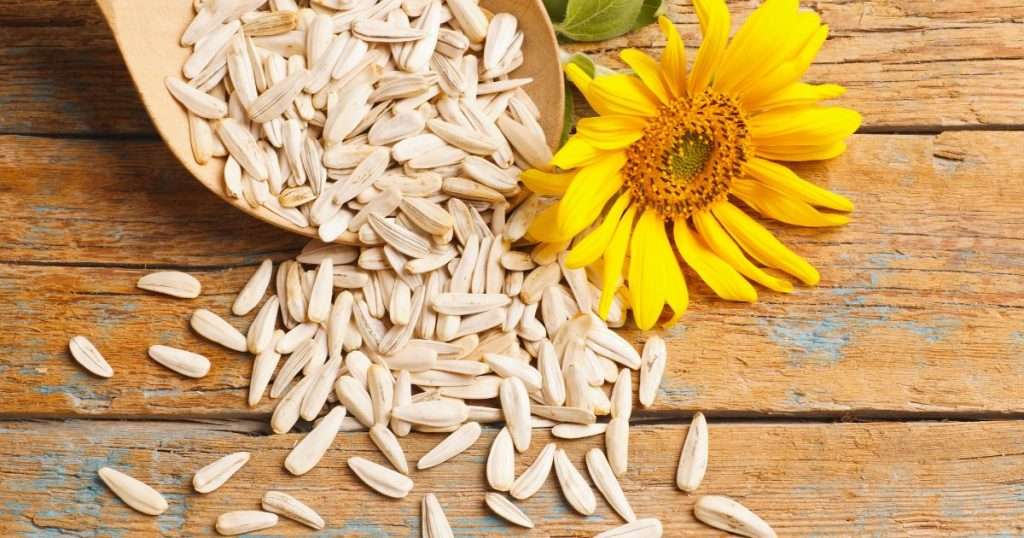
Monitoring The Drying Process: Signs Of Readiness
Below are some things that you should look for when monitoring the drying process.
1. Look for color changes
A sure sign that sunflowers are ready to be harvested is a change in their color. As the drying process progresses, the vibrant yellow petals of a sunflower will begin to fade and turn brown. The center disk, which contains the seeds, will also start to dry out and darken.
2. Check for drooping
When sunflowers have reached full maturity, their stems may start to droop slightly. This is because as the plant dries out, it becomes less rigid and more flexible. However, excessive wilting or bending may indicate dehydration or disease.
3. Examine seed heads
The easiest way to determine if your sunflower is ready for harvesting its seeds is by examining its seed head or flower head closely. When it’s fully matured, you’ll notice that the backside of each floret starts turning brown and drying up while facing away from the center.
Remember that properly drying sunflowers involves patience and careful monitoring of signs of readiness like color changes in petals and seed heads along with slight drooping in stems. Ready-to-harvest sunflowers ensure optimal storage conditions for long-lasting beauty or thriving bird feeders!
Preventing Mold And Mildew In Drying Sunflowers
To prevent mold and mildew from forming on your drying sunflowers, it is essential to follow these expert tips:
- Proper air circulation: Place your drying sunflowers in a cool, well-ventilated area with good air circulation. This helps reduce the humidity around the flowers, making it harder for mold and mildew to grow.
- Avoid moisture exposure: Keep your drying sunflowers away from areas with high humidity or direct sunlight, as these conditions can promote moisture accumulation. Additionally, make sure the flowers are not subjected to any water splashes or spills during the drying process.
- Regularly inspect for signs of mold: Check your sunflowers regularly while they dry for any signs of mold or mildew growth. If you notice any spots or discoloration on the petals or stems, remove them immediately to prevent further spread.
By following these simple preventive measures, you can ensure that your drying sunflowers remain beautiful and free from unwanted mold and mildew infestations!
Tips For Preserving Sunflower Colors During Drying
To keep your sunflowers vibrant and colorful during the drying process, follow these expert tips:
- Harvest at the right time: Pick sunflowers when their petals are fully opened but before they start to wilt or turn brown. This ensures that you capture their brightest hues.
- Remove leaves and excess foliage: Trim away any leaves or extra greenery from the stem, as they can draw moisture away from the flower head and cause discoloration.
- Hang upside down in a cool, dark space: Placing the sunflower heads upside down in a well-ventilated area helps them maintain their colors by preserving natural pigments. Avoid exposing them to direct sunlight or high temperatures that can cause fading.
- Use desiccants for quicker drying: If you want to speed up the drying process while maintaining color integrity, consider using silica gel or another desiccant agent. These materials help remove moisture without affecting floral pigments.
Remember these tips to ensure that your dried sunflowers retain their striking colors and serve as beautiful decorations for years to come.
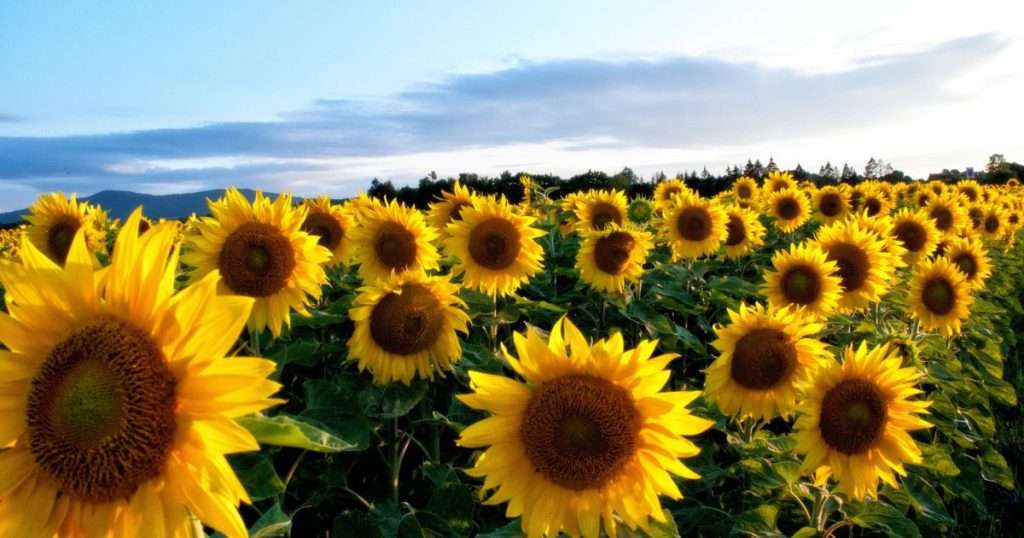
Techniques For Drying Sunflowers With Seeds Intact
Method 1: Air-Drying
- Cut sunflower heads when the petals have fallen and the back of the head has turned brown.
- Hang upside down in a well-ventilated area, such as a garage or shed, to dry naturally.
- Cover each head with a paper bag to catch any seeds that may fall out during drying process.
- Allow approximately two weeks for complete drying.
Method 2: Oven-Drying
Note: This method is quicker but requires close monitoring to prevent burning.
- Preheat oven to 350°F (175°C).
- Lay sunflower blooms on baking sheets lined with parchment paper.
- Place in oven for about three hours or until the heads feel dry and crispy.
- Rotate trays halfway through baking time for even heat distribution.
- Let sunflowers cool completely before removing seeds from heads.
DRYING SUNFLOWERS OUT IN A VASE
- First, cut the stems at an angle to dry sunflowers out in a vase.
- Remove any leaves below the water line to prevent rotting.
- Place the sunflowers in a vase with 1-2 inches of water.
Letting Nature Take Its Course
- Allow the sunflowers to sit in a warm, dry place with good air circulation.
- Check on them regularly to ensure they are drying evenly.
- Within 2-3 weeks, your sunflowers should be fully dried and ready for display.
Best Practices:
- Whichever method you choose, inspect flowers regularly while drying to ensure no mold growth occurs; discard any damaged or moldy ones immediately. Take caution not to over-dry your sunflowers, as this could cause loss of seed viability.
Drying Sunflowers With Bent Necks: Tips And Tricks
If you want to preserve sunflowers with bent necks, follow these expert tips:
- Cut the stems at an angle: When harvesting sunflowers, make sure to cut the stems at a sharp angle rather than straight across. This allows for better water absorption when placing them in a vase or drying rack.
- Remove lower leaves: To prevent wilting and rot, remove any lower leaves that would be submerged in water or touching the surface of a drying rack.
- Use silica gel: Place the cut sunflower heads face down in a container filled with silica gel beads, which help absorb moisture from flowers without distorting their shape.
- Avoid exposure to direct sunlight: During the drying process, keep your harvested sunflowers away from direct sunlight as it can cause premature fading and discoloration.
Remember these tips to effectively dry your beautiful sunflowers while maintaining their unique bent necks!
Reviving Dull Sunflowers: Restoring Their Beauty
Sunflowers can lose their vibrant color and appear dull after they have been dried. However, with the right techniques, reviving these sunflowers and restoring their beauty is possible. Here are some expert tips to help you bring life back into your dried sunflowers:
- Hydration: To rehydrate your dry sunflowers, submerge the stems in water for a few hours or overnight. This will allow the flowers to absorb moisture and regain their supple texture.
- Pruning: Trim any damaged or faded petals from each bloom using sharp scissors or pruning shears. Removing these wilted parts will give your sunflowers a fresher and healthier appearance.
- Steam treatment: Gently hold each flower over boiling water for 10-20 seconds. The steam will rejuvenate the petals, allowing them to open up fully and showcase their rich colors once again.
Remember that not all varieties of sunflowers respond well to revival techniques, so it’s essential to test these methods on a small sample before attempting them on your entire bouquet.
Storing Dried Sunflowers: Best Practices
When it comes to storing dried sunflowers, following these best practices will help ensure their longevity and preserve their beauty:
- Choose the right container: Select a clean, dry, and airtight container. Mason jars or plastic containers with tight-fitting lids work well.
- Keep away from moisture: Moisture can cause mold and rot, so avoid storing dried sunflowers in damp areas like basements or bathrooms.
- Find cool storage space: Sunflowers should be stored in a cool location away from direct sunlight. A pantry or cupboard is ideal.
By following these simple tips, you can keep your dried sunflowers looking vibrant for an extended period and enjoy them as unique decorative pieces in your home.

Drying Sunflowers for Decorating
- After harvesting sunflowers, tie them together in small bunches and hang them upside down in a well-ventilated area.
- Ensure the sunflowers are not exposed to direct sunlight or extreme heat while drying to prevent wilting.
- It may take up to two weeks for the sunflowers to fully dry.
Once your sunflowers are dried, you can use them for various decorating purposes, such as:
- Creating DIY wreaths
- Adding a rustic touch to floral arrangements
- Making beautiful wall hangings or centerpieces
Harvest partially open sunflowers.
Gather partially opened sunflowers, ensuring a decent stem length when cutting. Suspend the flowers in a dim, arid spot for a fortnight to dry thoroughly.
Regularly inspect the progress to guarantee proper drying. Following this period, treat the dried blooms with hairspray to conserve and enhance their sheen.
Evenly coat all surfaces of the flower for optimal effect. Your preserved sunflowers are primed for showcasing or incorporating into diverse crafts and decorative arrangements, adding a touch of natural elegance to any setting.
Creative Ways To Display Dried Sunflowers
- Floral Wreath: Use a glue gun to secure dried sunflower heads and other dried flowers and foliage onto a wreath frame made of wire or grapevine. For a charming and rustic touch, hang the wreath on your front door or inside your home.
- Sunflower Bouquet: Gather several dried sunflowers together and tie them with a ribbon or twine. Place the bouquet in a decorative vase or hang it upside down from a hook. This DIY arrangement will make an eye-catching centerpiece for any room.
- Wall Art: Hot glue dried sunflower stalks vertically onto canvas to create an elegant wall art piece that adds warmth and charm to any living space. Experiment with different sizes and arrangements to find a design that suits your taste.
HOW TO USE YOUR DRIED SUNFLOWERS
Home Decor:
Utilize your dried sunflowers to craft stunning floral arrangements or wreaths, which enhance your home decor. Display them elegantly in a vase or basket to infuse any space with a touch of natural beauty.
Photo Frames:
Dried sunflowers add a distinctive and personalized touch to photo frames. This easy DIY project elevates pictures, making them stand out while adding a vibrant splash of color to the frame.
Wedding Decor:
Dried sunflowers, infusing your wedding decor with the rustic charm of nature, can be incorporated into centerpieces, bouquets, or table decorations to create a warm and inviting ambiance. They will add a delightful touch of nature’s elegance to your special day.
Using Dried Sunflowers In DIY Crafts And Home Decor
Dried sunflowers are a versatile addition to any DIY project or home decor scheme. Here are some ideas on how to incorporate them into your creative endeavors:
- Floral Arrangements: Add dried sunflowers to bouquets or create stunning centerpieces by combining them with other dried flowers and herbs.
- Wreaths: Make a statement with a beautiful sunflower wreath that can be hung on doors or walls, adding warmth and charm to any space.
- Artwork: Pressed or preserved sunflowers can be framed and displayed as unique pieces of artwork, bringing nature’s beauty indoors.
No matter how you choose to use dried sunflowers, their vibrant colors and distinctive shape will add an eye-catching element that is sure to impress. So get creative and let these sunny blooms brighten up your crafting projects and home decor.
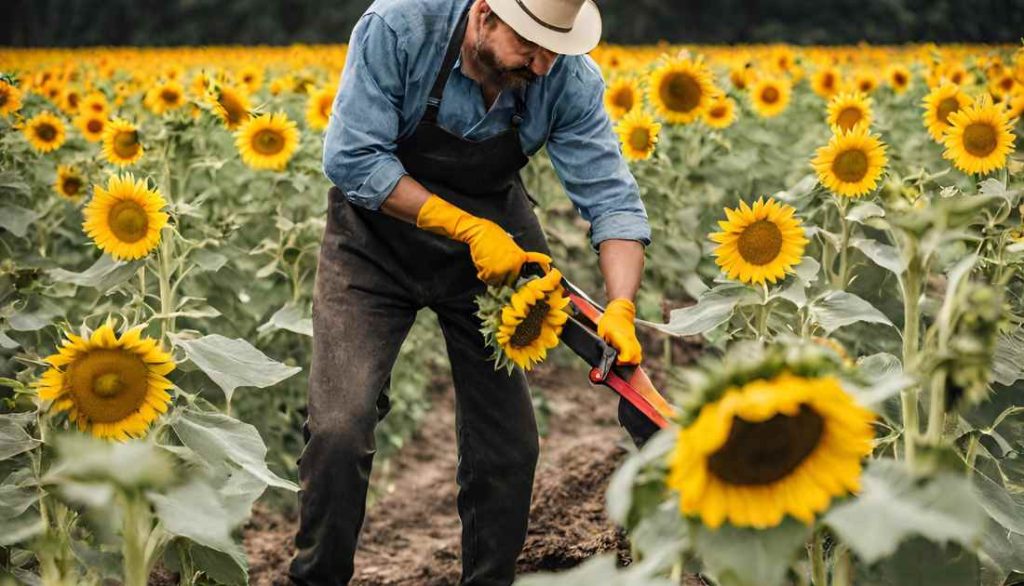
A How-To Guide Of Dried Sunflowers As Natural Bird Feeders
Drying sunflowers not only serves as a beautiful way to preserve these vibrant blooms but also creates an opportunity to attract feathered friends to your garden. Follow these simple steps to turn your dried sunflowers into natural bird feeders:
- Harvesting: Wait until the petals have fallen off and the seeds fully mature before sunflower heads are harvested.
- Cleaning: Remove any excess debris or dirt from the flower heads by gently brushing them with a soft cloth or brush.
- Remove Seeds: Carefully remove the seeds from each floret of the sunflower head, taking care not to damage them.
- Drilling Holes: Using a drill with a small bit, create holes around the edge of each sunflower head for birds to easily access the seeds.
- Hanging or Placing: Hang or place your dried sunflower seedheads in areas where birds often frequent, such as near trees, bushes, fencing, or bird feeders.
- Enjoy Watching Birds: Sit back and watch as various species of birds visit your garden to enjoy their delicious feast!
By repurposing dried sunflowers into natural bird feeders, you can effortlessly bring both aesthetic appeal and wildlife enjoyment to your outdoor space.
Drying Sunflowers with Drying Agents
Cut the stem short: When drying sunflowers, it’s essential to cut the stem short to help speed up the drying process. This will also make fitting the flower in your chosen drying container easier.
Try silica gel: Silica gel is a popular choice for drying sunflowers as it helps preserve their color and shape. Bury the sunflower head in silica gel and leave it until completely dried.
Create your drying container: You’ll need a suitable container to dry sunflowers effectively.
Fill this container with your chosen drying agent, cornmeal, borax mixture, or silica gel, and place your sunflower inside. Remember to keep the container in a warm, dry location for best results.
Drying Sunflowers for Seeds
As sunflowers mature, please leave them in the ground for optimal seed development. Drape cheesecloth over the flower heads to shield the seeds from hungry birds. When ready, slice the sunflower stem at an angle to facilitate drying. Let the sunflower heads hang in a well-ventilated area for a few weeks.
Once the seeds are dry, gently pluck them from the flower head. To prepare for consumption, consider roasting the seeds with salt or seasoning for a tasty and nutritious snack. Enjoy the fruits of your labor and savor the natural goodness of homegrown sunflower seeds.
Drying Sunflower Petals
- Collecting sunflower petals is the first step in the process.
- Handle them gently to avoid damage.
- Lay them out evenly on a flat surface.
- Apply gentle pressure to the petals to start the drying process.
- Ensure they’re spread out evenly to facilitate drying.
- After a while, check the petals for any signs of moisture.
- If they still feel damp, continue the drying process.
- Utilize a microwave for quicker drying.
- Place the petals between paper towels on microwave-safe plates.
- Microwave in short bursts, checking every 20 seconds to prevent burning.
- Rotate the plates and replace paper towels as needed for even drying.
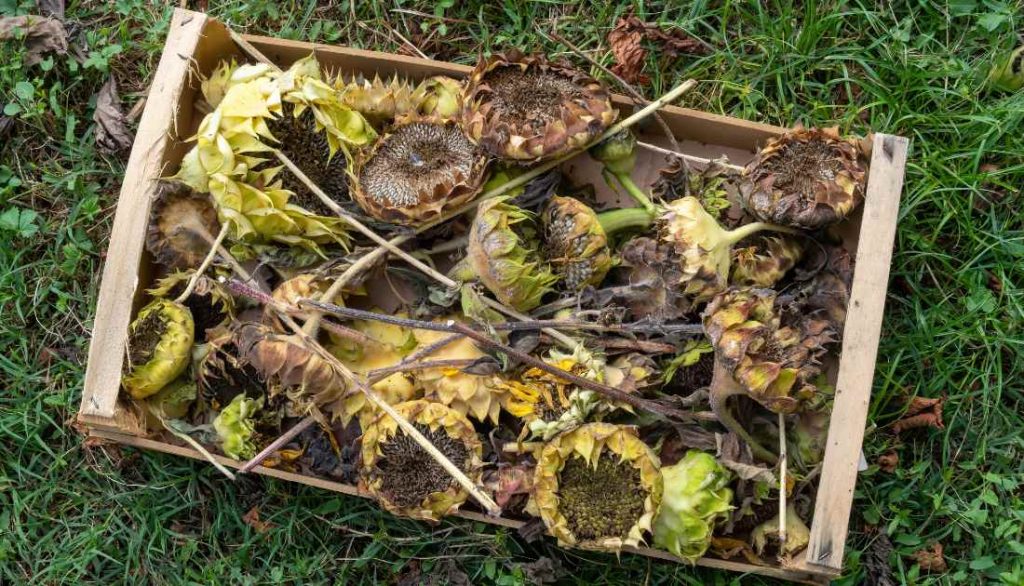
how to dry a sunflower
Frequently Asked Questions
How long does it take to dry sunflowers?
Drying sunflowers typically takes around two to three weeks. The drying time may vary depending on factors such as humidity and the size of the sunflower heads. Be patient during this process, as rushing it may result in wilted or damaged flowers.
What is the best way to dry sunflowers?
The most effective method for drying sunflowers is air-drying. To do this, hang the harvested sunflower heads upside down in a well-ventilated area that receives plenty of sunlight. Ensure that the flowers are not crowded together and have enough space between them for proper air circulation.
Can I use a dehydrator or oven to dry sunflowers?
Using a dehydrator or oven can speed up the drying process, but caution must be exercised. Low heat settings are recommended, ideally below 150°F (65°C), to prevent scorching or damaging the petals and seeds. It’s crucial to frequently check on your sunflowers while using these methods, as they can quickly become over-dried if left unattended.
Remember: Air-drying remains the safest and most reliable method for preserving your beautiful dried sunflowers!
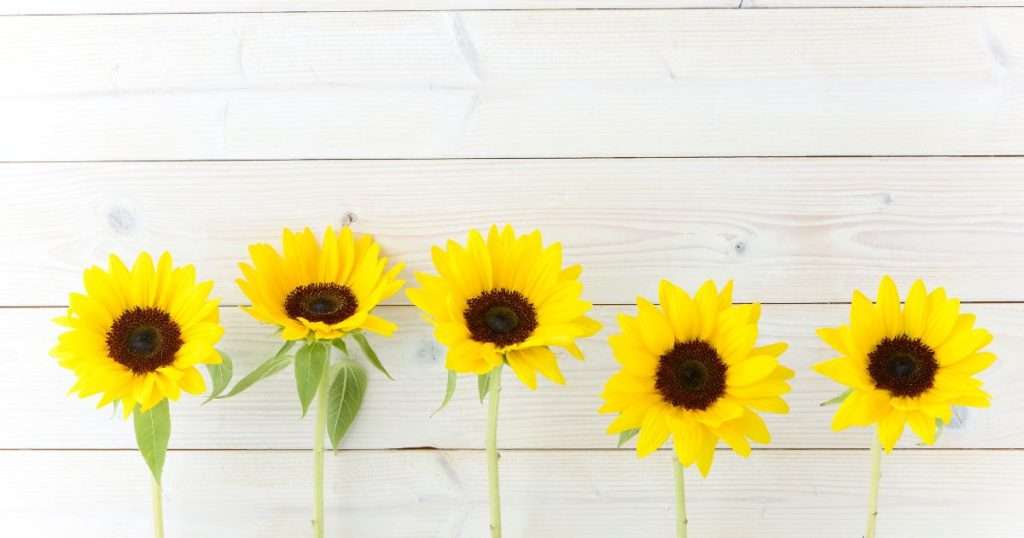
Troubleshooting Common Issues In Sunflower Drying
Problem: Mold and mildew growth
- Ensure that the sunflowers are fully dry before storing them. Any moisture left in the flowers can lead to mold and mildew growth.
- Increase air circulation by placing a fan near the drying area or using a dehumidifier to prevent excessive humidity.
Problem: Discoloration of petals
- Avoid exposing the sunflowers to direct sunlight during drying as it can cause discoloration of the petals.
- If discoloration occurs, trim off any affected petals before arranging or displaying dried sunflowers.
Problem: Loss of vibrant color
- Harvest sunflowers at their peak when they have fully opened and their colors are vibrant.
- Dry them quickly after harvesting to preserve their color. Slow or prolonged drying can lead to faded, dull colors.
- Store dried sunflowers in airtight containers away from sunlight to maintain their vibrancy for longer periods.
By following these troubleshooting tips, you’ll be able to overcome common issues encountered while drying sunflowers, resulting in beautiful and long-lasting dried flower arrangements.
Expert Tips For Long-Term Sunflower Preservation
Storing Sunflowers for Long-Term Preservation
- Choose your containers wisely: Avoid using plastic bags or tight containers that can trap moisture. Instead, opt for paper or mesh bags that allow the flowers to breathe and prevent mold growth.
- Prepare the flowers properly: Remove any excess foliage and trim the stems to a uniform length before storing. This not only enhances their appearance but also helps maintain their freshness during preservation.
- Find a cool, dry location: To maximize shelf life, store sunflowers in a well-ventilated area away from direct sunlight and humidity. Basements or closets with controlled temperatures make ideal storage spaces.
Maintaining Sunflower Quality Over Time
- Inspect routinely: Regularly check your stored sunflowers for signs of damage, drying out, or insect infestations. Promptly remove any affected blooms to prevent further deterioration among others.
Adjust as needed: If you notice your stored sunflowers beginning to wilt or lose color over time, try refreshing them by placing them in fresh water with added floral preservatives. Change the water every few days to keep it clean and clear of bacteria.
These simple tips will help ensure that your beloved sunflowers remain beautiful and vibrant even after they have been dried for long-term preservation purposes.
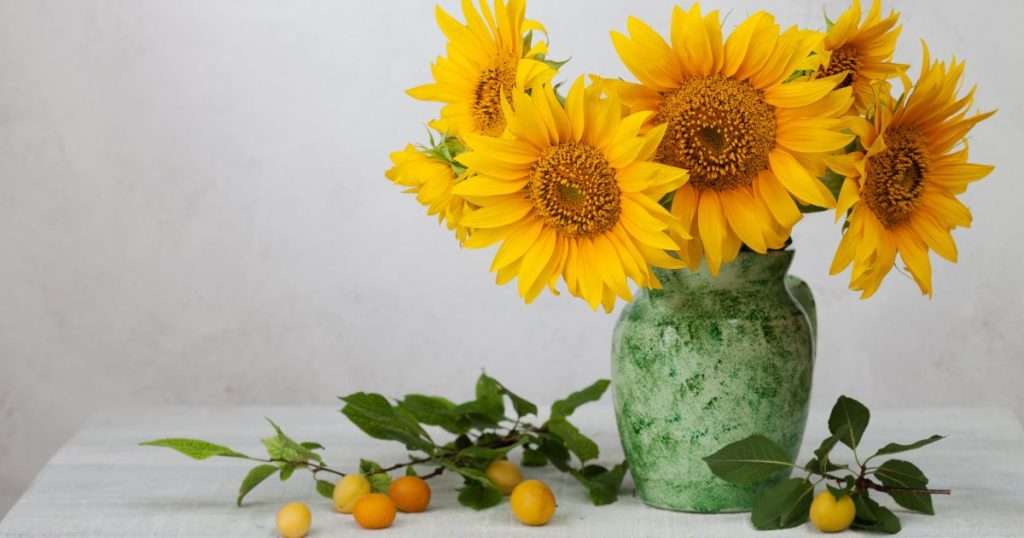
Conclusion
Drying sunflowers is a simple and rewarding process that allows you to enjoy the beauty of these vibrant flowers for months to come. Following above stated expert tips, you can ensure that your sunflowers dry evenly and retain their color and shape.
Whether you plan on using dried sunflowers in crafts, home decor, or simply as a stunning centerpiece, these techniques will help you achieve the best results. So go ahead and give it a try. With just a little time and effort, you can create beautiful dried sunflowers that will brighten up your space all year round.
